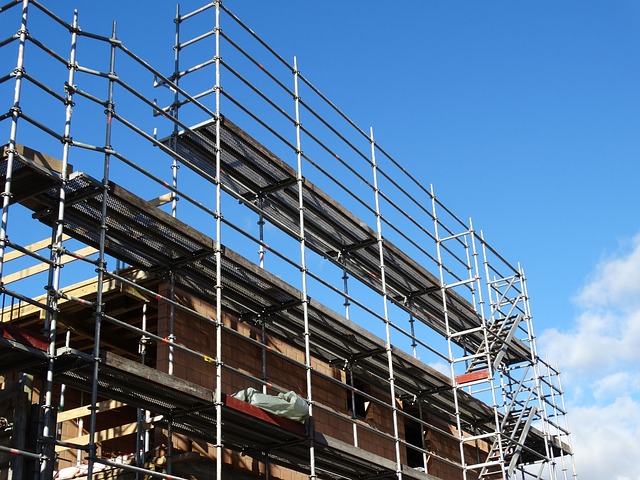Scaffolding
Scaffolding provides a temporary safe working platform for activities such as:
It is formed from individual tubes and joints or proprietary components.
There are two main types of scaffolding:
- Freestanding scaffolds, such as Independent towers,
- Independent tied scaffolds, such as independent towers tied to an adjacent structure.
NB For more types of scaffold, see Types of scaffolding.
The most common piece of structure used in scaffolding is the scaffold tube (known as a standard). The tube generally comes in two thicknesses, 3.2 mm or 4 mm. The tubes are galvanised due to their exposure to the elements and axial capacity loads are given either ‘as new’ or ‘used.’ Capacities of tubes used in tension are usually limited by the safe slip load capacity of the coupler, which is far lower than the actual tensile resistance of the tube.
Scaffolding is designed for its self-weight, i.e. the weight of the boards, tubes, guardrails, toeboards, etc. and imposed loads such as wind. The imposed load applied to the scaffolding depends on its use.
Four classes of loading are available:
- Service Class 1 - 0.75 kN/m2 – Inspection and very light duty access
- Service Class 2 - 1.50 kN/m2 – Light duty such as painting and cleaning
- Service Class 3 - 2.00 kN/m2 – General building work, brickwork, etc.
- Service Class 4 - 3.00 kN/m2 – Heavy duty such as masonry and heavy cladding
The wind load applied to scaffolding will change depending on whether sheeting or debris nets are used. The magnitude of the wind load will alter the required capacity of the ties and may affect their frequency.
When scaffolding is tied to a building it uses the permanent structure of the building to provide stability. The selection of tie positions should be tested and checked before use and the suitability of the permanent structures composition to carry the ties should be analysed.
Scaffolding is also braced laterally using façade and ledger bracing.
Workmanship and inspection is vital for the erection and dismantling of scaffolding and must be undertaken by competent personal under supervision.
For more information, see Scaffold register.
For information about removing scaffolding, see How to remove scaffolding.
The National Access and Scaffolding Confederation (NASC) has published TG20:21, which provides the definitive guidance for scaffolding constructed with tube and fittings throughout the UK. TG20 comprises four elements; the Operational Guide, the Design Guide, the User Guide and the NASC’s innovative, user-friendly and widely-adopted eGuide software.
Up until March 2021, this bundle came only in the form of three hard copy guides and a digital download, and was titled TG20:13. TG20:13 was formally withdrawn, in favour of fully adopting TG20:21, on October 12 2021. Further information can be found here.
Through TG20:21 the guides and eGuide are now available online, with the improved and expanded software and the associated and updated Operational and Design Guides accessible via the NASC ePortal.
The NASC has five membership categories; Contractor, Supplier, Design, Information and International Information.
[edit] Related articles on Designing Buildings
- Building wraps.
- CDM.
- Debris netting.
- Demolition.
- Facade retention.
- Falsework.
- Formwork.
- Gantry.
- How to remove scaffolding.
- How to use a ladder.
- Putlog holes.
- Roped access for conservation projects.
- Rubble chute.
- Scaffold register.
- Shoring.
- Temporary works.
- Ties.
- Trench support.
- Types of crane.
- Types of scaffolding.
- Work at height.
- Work at height checklist for managers.
- Work at height regulations.
- Working platform.
[edit] External references
- BS5975:2008 + A1: 2001 Code of Practice for Temporary Works Procedures and the Permissible Stress Design of Falsework (BSI 2011).
- The National Access And Scaffolding Confederation (NASC).
- Scaffolding Safety Tips
Featured articles and news
Building Safety Regulator reforms
New roles, new staff and a new fast track service pave the way for a single construction regulator.
Cooling centres and cool spaces
Managing extreme heat in cities by directing the public to places for heat stress relief and water sources.
Winter gardens: A brief history and warm variations
Extending the season with glass in different forms and terms.
Restoring Great Yarmouth's Winter Gardens
Transforming one of the least sustainable constructions imaginable.
Construction Skills Mission Board launch sector drive
Newly formed government and industry collaboration set strategy for recruiting an additional 100,000 construction workers a year.
New Architects Code comes into effect in September 2025
ARB Architects Code of Conduct and Practice available with ongoing consultation regarding guidance.
Welsh Skills Body (Medr) launches ambitious plan
The new skills body brings together funding and regulation of tertiary education and research for the devolved nation.
Paul Gandy FCIOB announced as next CIOB President
Former Tilbury Douglas CEO takes helm.
UK Infrastructure: A 10 Year Strategy. In brief with reactions
With the National Infrastructure and Service Transformation Authority (NISTA).
Ebenezer Howard: inventor of the garden city. Book review.
The Grenfell Tower fire, eight years on
A time to pause and reflect as Dubai tower block fire reported just before anniversary.
Airtightness Topic Guide BSRIA TG 27/2025
Explaining the basics of airtightness, what it is, why it's important, when it's required and how it's carried out.
Construction contract awards hit lowest point of 2025
Plummeting for second consecutive month, intensifying concerns for housing and infrastructure goals.
Understanding Mental Health in the Built Environment 2025
Examining the state of mental health in construction, shedding light on levels of stress, anxiety and depression.
The benefits of engaging with insulation manufacturers
When considering ground floor constructions.
Lighting Industry endorses Blueprint for Electrification
The Lighting Industry Association fully supports the ECA Blueprint as a timely, urgent call to action.






















